Hudson River Almanac 3/30/19 - 4/05/19
The New York State Department of Environmental Conservation sent this bulletin on 04/12/2019 02:00 PM EDT |
| DEC Delivers - Information to keep you connected and informed from the NYS Department of Environmental Conservation |
| Share or view as a web page || Update preferences or unsubscribe |
Hudson River Almanac
|
Compiled by Tom Lake, Hudson River Estuary Program Consulting NaturalistOverviewAlewives (river herring) joined glass eels as another spring migrant in from the sea. The number of successful bald eagle nests was increasing. There were now so many bald eagle nests in the watershed, many not being closely monitored, that we had to extrapolate their success from those we know.Highlight of the Week 4/3 – Adirondack Mountains: In seasons past, Dr. Bob Schmidt and I have had an informal, somewhat competitive, search for the largest white sucker (Catostomus commersoni) in the watershed. Bob’s 510-millimeter (mm) sucker (20.1-inches) had been topped only by my 520 mm (20.4-inches) fish, both caught in tidal tributaries. These two appeared to be at the size-ceiling for the species, at least in our watershed. 4/3 – Adirondack Mountains: In seasons past, Dr. Bob Schmidt and I have had an informal, somewhat competitive, search for the largest white sucker (Catostomus commersoni) in the watershed. Bob’s 510-millimeter (mm) sucker (20.1-inches) had been topped only by my 520 mm (20.4-inches) fish, both caught in tidal tributaries. These two appeared to be at the size-ceiling for the species, at least in our watershed. Yesterday, Bob Schmidt was curating a collection of 50 white suckers at the New York State Museum in Albany when he came upon a huge sucker, 740 mm (29.1-inches). The fish had been captured on May 10, 2013, at the mouth of Bottle Brook, a small tributary of Seventh Lake, east of Old Forge, Herkimer County (Lake Ontario watershed). The giant sucker, a female, had migrated upstream from Seventh Lake to spawn. C. Lavett Smith in his Inland Fishes of New York (1985), recalls unsubstantiated reports of 28-inch-long white suckers in Lake Erie. As a result of Bob’s discovery, this fish may be a state record, and our search for the largest white sucker within the Hudson watershed continues. (Photo of white sucker courtesy of Deborah Tracy-Kral) - Tom Lake [Note: one inch = 25.4 millimeters (mm)] [Suckers, in general, are elongate and terete in cross-section. They have what ichthyologists refer to as an “inferior mouth,” in that it is angled downward. This adaptation allows suckers to effectively feed off the bottom where they find a broad variety of insect larvae. With a snorkel mask you can watch them inhale a mouthful of bottom sand and sediment, sort out the edibles, and then exhale the rest. In spring, an adult male white sucker will have a broad red stripe on each side of its body (breeding colors), and many tiny bumps (breeding tubercles) on its anal fin and caudal (tail) fin. Breeding tubercles are thought to aid the males in maintaining contact with females. From Colonial times through the mid-20th century, there was a cottage industry for smoking and pickling suckers in the watershed. They are a delightful fish! Tom Lake] Natural History Entries 3/30 – Newcomb, HRM 302: We ventured to Newcomb today to check our camp that was still closed for the winter (our long driveway requires snowshoes to traverse in winter). There was still a snow-pack of three-feet in the woods, and the roadside banks were even deeper. Goodnow Flow (lake) was still frozen, but the various feeder streams were moving freely and beginning to erode the lake ice where they entered. The earliest I have been able to open our camp was April 16, eight years ago. I generally can open when the ducks can no longer ride the ice floes. 3/30 – Newcomb, HRM 302: We ventured to Newcomb today to check our camp that was still closed for the winter (our long driveway requires snowshoes to traverse in winter). There was still a snow-pack of three-feet in the woods, and the roadside banks were even deeper. Goodnow Flow (lake) was still frozen, but the various feeder streams were moving freely and beginning to erode the lake ice where they entered. The earliest I have been able to open our camp was April 16, eight years ago. I generally can open when the ducks can no longer ride the ice floes.On our drive through Newcomb, almost as if on cue from our correspondence, we noticed two white-tailed deer crossing the partially-frozen Hudson River a short distance upstream from the Route 28N highway bridge. The ice was gray and thin, yet both deer crossed safely without so much as a wet hoof. I felt much safer standing on the bridge. (Photo of white-tailed deer courtesy of Roy Saplin) - Roy Saplin 3/30 – Minerva, HRM 284: We still had three-feet of snow in Minerva. The sugar maple sap was running a little better, but it will not be the big season we had for maple syrup last year. So far, I've made a pint of dark, sweet syrup. Presently, I've got sap on the stove boiling down to evaporate the water. Last year, I made well over half a gallon. I visited the local commercial maple syrup business in Minerva and heard that it might not be a great year for them as well. Meanwhile we’ve had a scattering of robins and some red-winged blackbirds passing through. Spring is coming, slow but sure. - Mike Corey 3/30 – Beacon, HRM 61: Today’s fish catches, two carp and one channel catfish during a six-hour session, were widely dispersed during the last of the ebb tide and the first of the flood. The carp were weighed before release (10 pounds, 13 ounces, and 10 pounds, 8 ounces). The larger one measured 28-inches. The channel catfish was 20-inches and weighed 2 pounds, 8 ounces. The catfish had a raw back wound. Head and back wounds are frequently found among male channel catfish due to their early season nest-building activities among rocks and boulders in anticipation of the up-coming spawn. The river was 42 degrees Fahrenheit (F) - Bill Greene [Spring fishing is an activity that requires patience. When I was teaching at Fordham University, I invited Dan Rather to speak to my business students. I remember one of his memorable comments regarding success, in that it depends 90% on showing up, 8% on persisting and not quitting, and 2% on talent. That comment seemed applicable to March fishing. Bill Greene] 3/30 – Bedford, HRM 35: The great blue heron rookery now appeared to have 17-occupied nests. Seven nests had a pair of herons with one incubating and the other standing guard either on the rim of the nest or on a nearby branch. The guardians usually pass the time preening their feathers. The remaining nests had a single heron incubating with its mate most likely off hunting. This will be the routine for the next month until the eggs begin to hatch. - Jim Steck 3/31 – Warren County, HRM 232: Driving south on Route 40 near DEC Headquarters in Warrensburg, I counted five bald eagles (four adults) spread across the Hudson River, standing on rocks in the shallows looking upstream, always hunting. One of the adults had a fish that it was busy dismembering. It was such a surreal moment! - Mike Schelin 3/31 – Black Creek, HRM 85: It was raining this morning near high tide as we picked our fyke net in Black Creek. We counted 743 glass eels. We do not usually see so many eels this early in the season. The water was 50 degrees F. - Sophia Hsieh  3/31 – Town of Poughkeepsie: In late afternoon, I watched as one of the adults from bald eagle nest NY62 brought a goldfish to the nest. Unlike the bright-orange goldfish we had been seeing this spring in the talons of eagles, this one was a dull, brassy, burnished-gold color. (Photo of bald eagle with goldfish courtesy of Debbie Lephew) 3/31 – Town of Poughkeepsie: In late afternoon, I watched as one of the adults from bald eagle nest NY62 brought a goldfish to the nest. Unlike the bright-orange goldfish we had been seeing this spring in the talons of eagles, this one was a dull, brassy, burnished-gold color. (Photo of bald eagle with goldfish courtesy of Debbie Lephew)- Debbie Lephew [Goldfish (Carassius auratus), are native to east Asia. While they were widely introduced into North America in the early nineteenth century, their presence in the watershed is most often attributed to aquaria release. Domesticated and bred for color, often hybridizing with koi (carp), Hudson River goldfish range from bright-orange to burnished-gold, often mottled with black. In the wild, goldfish can grow to 14 inches and weigh a couple of pounds. Tom Lake] 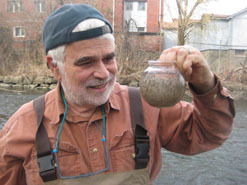 3/31 – Quassaick Creek, HRM 60: When we picked our fyke net three years ago today (2016), we were amazed by the number of glass eels that we had captured in our overnight set. This meant an entire afternoon counting glass eels. Several members of the media were there, but they all gave up after an hour of watching us count the tiny translucent fish. In all, it took us more than three exhausting hours to count the 6,004 glass eels. (Photo of glass eels courtesy of Tom Lake) 3/31 – Quassaick Creek, HRM 60: When we picked our fyke net three years ago today (2016), we were amazed by the number of glass eels that we had captured in our overnight set. This meant an entire afternoon counting glass eels. Several members of the media were there, but they all gave up after an hour of watching us count the tiny translucent fish. In all, it took us more than three exhausting hours to count the 6,004 glass eels. (Photo of glass eels courtesy of Tom Lake)- Hannah Ring, Tom Lake 4/1 – Hudson Valley: Earlier in the year, we suggested using caution when approaching bald eagle nests, especially when they were incubating. That plea for temperance of enthusiasm becomes even more critical when nestlings are present. Nestlings, as well as the adults, frighten easily with human intrusion. We should extend that caution to include all nesting birds and their nestlings. Potential consequences of our carelessness include nest abandonment and premature fledgling. We must let the power of our optics (binoculars and cameras) get us as close as we need to be. - Tom Lake  4/1 – Saratoga County, HRM 166: Scouting for wildlife today and on a small pond near Ballston Lake, I found a river otter as well as a bunch of different species of ducks including hooded mergansers and wood ducks. (Photo of hooded mergansers courtesy of Mike Lemery) 4/1 – Saratoga County, HRM 166: Scouting for wildlife today and on a small pond near Ballston Lake, I found a river otter as well as a bunch of different species of ducks including hooded mergansers and wood ducks. (Photo of hooded mergansers courtesy of Mike Lemery)- Mike Lemery (Hudson-Mohawk Bird Club) 4/1 – Manhattan, HRM 1: We checked our research sampling gear in Hudson River Park at The River Project's sampling station on the lighthouse tender Lilac at Pier 25 and found a meager catch of shore shrimp, amphipods, and a mud crab. This seems like the Lull before the Fish Storm! - Toland Kister, Melissa Rex 4/2 – Norrie Point, HRM 85: We got lucky today and witnessed a food delivery to bald eagle nest NY142, across the river in Ulster County. One of the adults was perched just off the nest when the second adult arrived. For the next five minutes, there was much feeding activity both inside and outside the nest. Although we could not see nestlings, the food delivery and feeding behavior suggested there may have been one. The timing was right as apparent incubation began on February 6 and adult recognition of something in the nest (eggs?) began on March 20. - Dave Lindemann, Rob Pistey 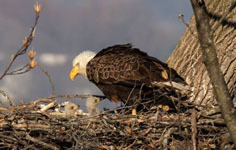 4/2 – Town of Poughkeepsie: Today’s menu for the two nestlings in bald eagle nest NY62 included a mallard duck and a channel catfish. The nestlings were eating well thanks to the longevity (19 years) and experience of their parents. (Photo of two bald eagle nestlings courtesy of Bob Rightmyer) 4/2 – Town of Poughkeepsie: Today’s menu for the two nestlings in bald eagle nest NY62 included a mallard duck and a channel catfish. The nestlings were eating well thanks to the longevity (19 years) and experience of their parents. (Photo of two bald eagle nestlings courtesy of Bob Rightmyer)-Bob Rightmyer 4/2 – New Hamburg, HRM 67.5: Bald eagle nest NY459 had become an enigma. We had not seen any adult activity in more than a week. Yet today, there was an adult in the nest and the other adult was perched ten feet way. Were they still trying? Or was this instinctive remorse for eggs that did not hatch? - Tom Lake, B.J. Jackson [NY459 was a new bald eagle nest in 2018, and hatched two nestlings. On May 16, a massive storm that included tornados, destroyed the nest, dumping the two nestling onto the forest floor. With help from Gary and Mauricette Char Potthast, Meghan Oberkircher, and Annie Mardiney. the two nestlings survived. By June 26, the pair had begun to rebuild and the 2019 breeding season looked promising. Tom Lake] 4/2 – Yonkers, HRM 18: After two days of impressive glass eel numbers (March 26: 103; March 28: 53) our 9-11 grade students from the Bio-Chem program at Saunders High School in Yonkers caught 73 today in our eel mop. Across these eight days, the water temperature had risen from 47 to 50 degrees F. - Brenda Jandres 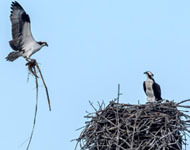 4/3 – Ulster County: A returning pair of osprey have been busy refurbishing their nest. Each adult has been bringing suitable material to the nest, and today, one of them brought a gorgeous bright-orange goldfish (goldfish have been extremely popular with bald eagles and osprey this spring!). (Photo of osprey nest courtesy of Jim Yates) 4/3 – Ulster County: A returning pair of osprey have been busy refurbishing their nest. Each adult has been bringing suitable material to the nest, and today, one of them brought a gorgeous bright-orange goldfish (goldfish have been extremely popular with bald eagles and osprey this spring!). (Photo of osprey nest courtesy of Jim Yates)- Jim Yates [As with many bald eagle and osprey nests that are judged to be vulnerable to human intrusion, exact locations are kept very discreet to protect the adults and their nestlings. Tom Lake] 4/3 – Manitou, HRM 46.5: Nearby bald eagle nest NY527 appeared to have a nestling. We watched an adult feeding at least one eaglet today, and we could see a gray downy head reaching up to be fed. Both parents have been quite attentive during feeding and with nest maintenance. - Owen Sullivan, Zshawn Sullivan 4/3 – Verplanck, HRM 40.5: It is with great pleasure that we observed that the pair of osprey had returned to the channel marker off Steamboat Dock in Verplanck. This was at least the third year for this nesting pair. Every day we have watched tirelessly searching for just the right branch to bring back to the newly refurbished nest. The pair accumulates quite a nice bundle of sticks each season but the Coast Guard Aids to Navigation team clears off the markers each spring before the birds arrive. This usually necessitates a complete rebuild. - Dianne Picciano 4/4 – Warren County, HRM 230: We could still feel the chill of winter in the air. A month earlier I was ice-fishing on Lake George; now remnants of the ice began 100 feet offshore and extended up the lake to the north as far as we could see, which soon became a diminishing view. What began as flurries soon built into a snow squall, and then a total whiteout. Common loons (Gavia immer) – three of them in breeding plumage – were there diving for fish. These were the great northern divers, as they are known in Europe. Has there ever been a more appropriate name? - Tom Lake, T.R. Jackson [Although Lake George is only ten miles east of the Hudson River, due to typography, the lake belongs to the Saint Lawrence River watershed. Still, Lake George can claim a connection to the Hudson River watershed via the Hudson-Champlain Canal at Fort Edward (river mile 202). And since birds do fly, the loons of Lake George, on their way to the High Peaks of the Adirondacks, makes Lake George kin to our watershed. Tom Lake] 4/4 – Washington County, HRM 192-191: One of the best locations to see both variety and numbers of returning waterfowl in spring is Thompson Island Pool on the Hudson River. The jewel of the pool today was several hundred snow geese. Their voices. coupled with assorted-sized rafts of Canada geese, bufflehead, common mergansers, common goldeneye, ring-necked ducks, and greater scaup, created a loud symphony if not a harmony. - Tom Lake, T.R. Jackson 4/4 – Town of Poughkeepsie: There was much activity at bald eagle nest NY62 today, the highlight of which was when an intruder, an immature bald eagle, arrived and flew over the nest. The adult male from NY62 went up to head it away. Eventually, the female came off the nest, knowing her nestlings would be alright for a short period of time, and the two of them were able to chase the intruder away. - Dennis Manning [Immature bald eagles will occasionally show up unexpectedly at active nests. There are several theories as to why they do this. The immature could be last year’s fledgling remembering how good they had it once upon time; they could be a nearly-adult (nearing four-years-old) testing to see how strong the bond is with the resident adults (eagles are always looking for opportunities to replace one or the other), or simply an eagle in migration from wintering to breeding grounds (eagles can be inherently curious of other eagles). Tom Lake] 4/4 – New Hamburg, HRM 67.5: Just two days ago, we were thinking bald eagle nest NY459 had failed. Today, I made a commitment to watch the nest for an hour. It was not long before an adult flew into the back of the nest. At the same time, the other adult was up and out the “front door.” A change-over. That adult had been deep in the nest, out of sight. That may have been the reason that we missed the incubation. In light of today’s activity, it seems NY459 might still be in play. - Dana Layton 4/4 – Haverstraw Bay, HRM 36: Our DEC Hudson River Fisheries Unit crew was on Haverstraw Bay today gill-net sampling for immature sturgeon, and we caught two alewives, both males. These were the first ones of the season. - Amanda Higgs 4/4 – Yonkers, HRM 18: On a windy and warm day, our 9-11 grade students from the Bio-Chem program at Saunders High School in Yonkers caught 19 glass eels today in our eel mop as well as two elvers (probably last year’s glass eels). The water temperature continued to rise, now at 53 degrees F. - Brenda Jandres 4/5 – Haverstraw Bay, HRM 36: Our DEC Hudson River Fisheries Unit crew was on Haverstraw Bay again today gill-net sampling for immature sturgeon, and we caught two more alewives, this time both females (265, 289 mm). - Amanda Higgs *** Fish of the Week *** Now that winter has slowly retreated to points north, much of the watershed’s ponds, creeks, lakes, and rivers are ice-free and we are recovering from our winter fish withdrawal. For 13 weeks our Fish-of-the-Week feature has helped during a bleak fish-less winter. It has worked so well that we may continue the feature, at least until we get tired of taking space from real fish stories. 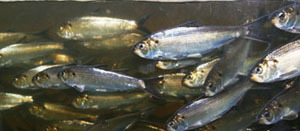 4/5 – Hudson River Watershed: This week’s fish is the alewife (Alosa pseudoharengus), a diadromous (migratory) species. The alewife is number 24 (of 228) on our watershed list of fishes. (If you would like a copy of our list, e-mail: trlake7@aol.com.) 4/5 – Hudson River Watershed: This week’s fish is the alewife (Alosa pseudoharengus), a diadromous (migratory) species. The alewife is number 24 (of 228) on our watershed list of fishes. (If you would like a copy of our list, e-mail: trlake7@aol.com.)[Alewife (Alosa pseudoharengus) is one of two river herring that includes blueback herring (A. Aestivalis), that stream into the Hudson River estuary by the millions each spring to spawn. They penetrate far upriver into tidewater tributaries. Some are lifted above the Federal Dam at Troy, climb the Waterford Flight, and venture far to the west in the Mohawk River. Alewives are usually the first river herring to arrive in late March. Blueback herring, with slightly different timing, ordinarily arrive by late April. Shoals of young-of-year alewives migrate seaward for most of the summer and autumn, following the message in their DNA to go to seawater. Some will return in 4-5 years as adults to spawn. But, to reach the ocean, requires them to navigate the lower estuary and New York Harbor where striped bass and bluefish are waiting to siphon off a large percentage. The odds of any one young-of-year herring reaching maturity is not much better than one-in-a-million. For that reason, to maintain a stable population, fishes like herring are programmed (adaptation) to produce millions of eggs. (Photo of alewives courtesy of John Burrows) Tom Lake] 4/5 – Rockland County, HRM 33: I’m pretty confident that bald eagle nest NY336 has a nestling. The behavior of the adults has been consistent with what I learned observing other eagles on nest cameras. The female has begun to sit higher in the nest, and while I have not seen food brought to the nest, the female appeared to be tearing food apart and then dipping deep inside the nest. The male has been consistently near the nest, especially around sunset when he settles into roost. - Chris Galligan 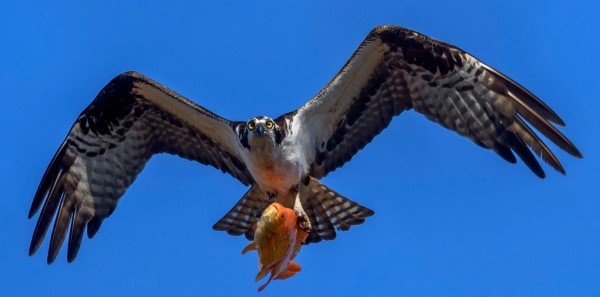 Spring-Summer 2019 Natural History ProgramsSaturday, April 27 (8:00 AM - 12:00 PM.. or later) Wednesday, July 10 - Thursday July 11 (9:00 AM - 5:00 PM) Tuesday, August 20 - Thursday August 22 (9:00 AM - 4:00 PM) Volunteer Opportunity: Hudson River Eel Project Hudson River: Striped Bass Cooperative Angler Program Here’s how it works: Fill out a logbook provided by us whenever you fish on the Hudson River (by boat or from shore). Record general location, time, gear used, what you caught (or if you didn’t catch anything) and return the logbook when you are done fishing for the season. You’ll receive an annual newsletter summarizing the information in addition to the latest news regarding regulations and the river. Whether you catch-and-release or take home a keeper, you can be part of the Cooperative Angler Program. Hudson River MilesThe Hudson is measured north from Hudson River Mile 0 at the Battery at the southern tip of Manhattan. The George Washington Bridge is at HRM 12, the Tappan Zee 28, Bear Mountain 47, Beacon-Newburgh 62, Mid-Hudson 75, Kingston-Rhinecliff 95, Rip Van Winkle 114, and the Federal Dam at Troy, the head of tidewater, at 153. The tidal section of the Hudson constitutes a bit less than half the total distance – 315 miles – from Lake Tear of the Clouds to the Battery. Entries from points east and west in the watershed reference the corresponding river mile on the mainstem. To Contribute Your Observations or to SubscribeThe Hudson River Almanac is compiled and edited by Tom Lake and emailed weekly by DEC's Hudson River Estuary Program. Share your observations by e-mailing them to trlake7@aol.com.
|
